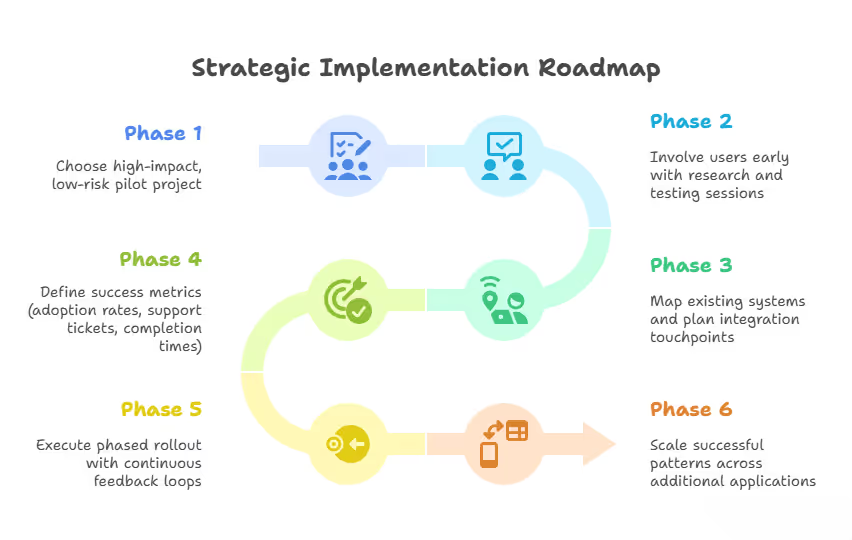UI as a Service: A Simple Guide for Developers and Teams

In today’s competitive digital landscape, businesses can’t afford to spend months designing and coding frontends from scratch. That’s where UI as a Service (UIaaS) comes in. By offering pre-built, customizable UI components through the cloud, UIaaS enables US product teams, startups, and enterprises to scale quickly while ensuring design consistency and faster time to market. For companies looking to streamline app development without compromising on user experience, UI as a Service is becoming a game-changer.
UI as a Service (UIaaS) is a cloud-based model that provides pre-built, reusable, and customizable user interface components to accelerate software development. Instead of building frontends from scratch, businesses, especially in the USA, use UI as a Service to reduce development costs, improve consistency, and launch products faster. Niral AI is the Best UI as a service Provider in USA for Enterprises.
What Exactly Is UI as a Service?
UI as a Service is pretty much what it sounds like, outsourcing your user interface development to specialized providers who eat, sleep, and breathe great design. Instead of assembling an internal team of designers, front-end developers, and UX researchers, you're tapping into a ready-made ecosystem of UI expertise.
But here's where it gets interesting for enterprise decision-makers: this isn't just about making things look pretty.
We're talking about a fundamental shift in how you approach ui development, one that can dramatically impact your bottom line, time-to-market, and user adoption rates.

Key Benefits of UI as a Service:
- Cost Reduction: Save 60-70% on UI development costs compared to in-house teams
- Speed to Market: Launch applications 3-4x faster with pre-built components
- Expert Design: Access world-class designers without hiring headaches
- Scalability: Handle user growth without infrastructure nightmares
- Compliance Ready: Built-in security and regulatory compliance features
- Integration Friendly: Pre-built connectors for enterprise software stacks
The Hidden Costs of In-House UI Development
Let me paint you a picture. Your CTO walks into your office and says, "We need a new customer portal. Our team can build it." Sounds reasonable, right?
But here's what that really means: You're looking at hiring 3-5 specialized developers, a UX designer, and a project manager.
That's easily $600K-$800K in annual salaries alone, before you factor in benefits, equipment, and the 6-month learning curve.
Real Costs of Building Internal UI Teams:
- Initial Hiring: $800K-$1.2M for full team setup and onboarding
- Training & Tools: $50K-$100K annually for software licenses and skill development
- Ongoing Salaries: $600K-$900K annual compensation packages
- Support & Maintenance: $200K-$400K yearly for system updates and bug fixes
- Opportunity Cost: 12-36 months before seeing production results
- Turnover Risk: 25-30% annual developer turnover requiring constant rehiring
The UI Service Revolution: Why Timing Matters
The enterprise software landscape has changed dramatically. Research conducted by Forrester Consulting indicated that a well-designed UI led to a 200% increase in user adoption rates for SaaS applications.
Your users, whether they're employees, customers, or partners, have been trained by Netflix, Spotify, and Amazon.
They expect interfaces that just work, and UI as a service providers have cracked the code on this.
Why Now Is the Perfect Time:
- User Expectations: Modern users expect consumer-grade interfaces in enterprise apps
- Technology Maturity: UI as a service platforms are now enterprise-ready
- Cost Pressures: Economic conditions demand more efficient development approaches
- Talent Shortage: Skilled UI developers are expensive and hard to find
- Speed Requirements: Market demands faster application delivery
- Competitive Advantage: Better interfaces directly impact business outcomes
The Business Case: Numbers That Make CFOs Smile
Let's talk ROI, because that's what really matters in the boardroom.
Long-term, investing in UX can lead to significant cost savings by reducing the need for extensive training, support, and system rework.
The math is pretty compelling. When you factor in the reduced training costs, lower support overhead, and faster time-to-market, UI as a service often pays for itself within the first year.
Enterprise-Grade Features That Actually Matter
Not all UI services are created equal, especially when you're dealing with enterprise requirements.
Here's what separates the pros from the pretenders when you accelerate UI development through professional services.
Enterprise ui service providers understand that your data governance isn't negotiable.
They've built their platforms with SOC 2 compliance, GDPR readiness, and enterprise-grade security from the ground up.
Critical Enterprise Features:
- Security & Compliance: SOC 2, GDPR, HIPAA compliance built-in
- Scalability: Handle 10K+ concurrent users without performance issues
- Integration APIs: Pre-built connectors for Salesforce, SAP, Microsoft 365
- Custom Branding: White-label solutions that match your brand identity
- Multi-tenant Architecture: Support multiple departments with role-based access
- Audit Trails: Complete logging for compliance and security monitoring
- SLA Guarantees: 99.9% uptime with performance monitoring
- Data Portability: Export capabilities to prevent vendor lock-in
The Real-World Impact: Beyond Pretty Interfaces
Let's get practical. Effective user interface design boosts user adoption, productivity, and cost savings while reinforcing brand identity and simplifying employee engagement.
But what does that look like in practice? When your interfaces are intuitive, you spend less time training users and more time on business outcomes.
Measurable Business Impact:
- Training Reduction: Cut onboarding time from 3 days to 3 hours
- Support Savings: 60-80% reduction in "how do I..." support tickets
- Productivity Gains: 25-40% improvement in task completion rates
- User Satisfaction: 80-95% user adoption vs. 40-60% with legacy systems
- Feature Velocity: Deploy new capabilities in weeks instead of months
- Revenue Impact: Better UX directly correlates with increased user engagement
Implementation Strategy: Getting It Right from Day One
Rolling out UI as a service isn't just about signing a contract and hoping for the best. Here's how enterprise leaders are approaching this successfully without the typical pitfalls.
Don't rebuild your entire digital ecosystem on day one.
Pick a customer-facing application or internal tool that's causing user complaints, use this as your proof of concept.

Step-by-Step Implementation:
- Phase 1: Choose high-impact, low-risk pilot project (customer portal, internal tool)
- Phase 2: Involve users early with research and testing sessions
- Phase 3: Map existing systems and plan integration touchpoints
- Phase 4: Define success metrics (adoption rates, support tickets, completion times)
- Phase 5: Execute phased rollout with continuous feedback loops
- Phase 6: Scale successful patterns across additional applications
Pricing Models That Make Business Sense
Enterprise UI as a service pricing has evolved beyond simple per-user models. Today's providers offer flexible options that align with business outcomes and provide predictable costs.
Usage-based pricing (UBP) is a pricing model that enables customers to pay for a product according to how much they use it.
This works particularly well for applications with variable usage patterns.
Risk Mitigation: What Could Go Wrong?
Let's address the elephant in the room. Outsourcing UI development isn't without risks, but they're manageable if you plan properly.
Choose providers that offer data portability and standard APIs. You should be able to migrate your UI components if needed, and establish clear design standards and review processes.
Common Risks and Solutions:
- Vendor Lock-In: Choose providers with standard APIs and data export capabilities
- Quality Control: Establish clear design standards and review processes upfront
- Performance Issues: Ensure SLAs for response times and uptime guarantees
- Security Concerns: Verify compliance certifications and security audit results
- Integration Failures: Test integration capabilities during pilot phase
- Cost Overruns: Negotiate fixed-price contracts with clear scope definitions
Future-Proofing Your UI Strategy
The UI as a service landscape is evolving rapidly. AI-powered design tools, voice interfaces, and augmented reality are becoming mainstream faster than most enterprises can adapt internally.
By partnering with specialized providers, you're essentially future-proofing your UI strategy.
These providers are investing in emerging technologies and incorporating them into their platforms.
Emerging Trends to Watch:
- AI-Powered Design: Automated layout optimization and personalization
- Voice Interfaces: Voice-first navigation for accessibility and efficiency
- Augmented Reality: AR overlays for complex enterprise workflows
- Low-Code Integration: Drag-and-drop interface building for business users
- Predictive UX: Machine learning-driven user experience optimization
- Cross-Platform Consistency: Unified interfaces across web, mobile, and desktop
Making the Business Case to Your Board
When you're presenting UI as a service to your board or executive team, focus on business outcomes rather than technical features. The numbers tell the story better than any technical demonstration.
Quantify how much faster you can deliver new capabilities to users, and present the total cost of ownership comparison, including hidden costs like training and support.
Key Board-Level Arguments:
- Time-to-Market: Deliver new capabilities 3-4x faster than competitors
- Cost Reduction: 60-70% savings on UI development and maintenance
- Risk Mitigation: Reduce project failure risk with proven solutions
- Competitive Advantage: Superior user experience differentiates your offerings
- Resource Optimization: Free up internal teams for core business functions
- Future Readiness: Access to emerging technologies without R&D investment
The Bottom Line
UI as a service isn't just a trend, it's a fundamental shift in how smart enterprises approach user experience. While your competitors are still debating whether to hire more designers, you could be delivering world-class interfaces that drive user adoption and business results.
The question isn't whether UI as a service will become mainstream in enterprise software, it's whether you'll be an early adopter who gains competitive advantage or a late adopter who plays catch-up.
Your users deserve interfaces that don't suck, and your business deserves the competitive advantage that comes from exceptional user experiences.

